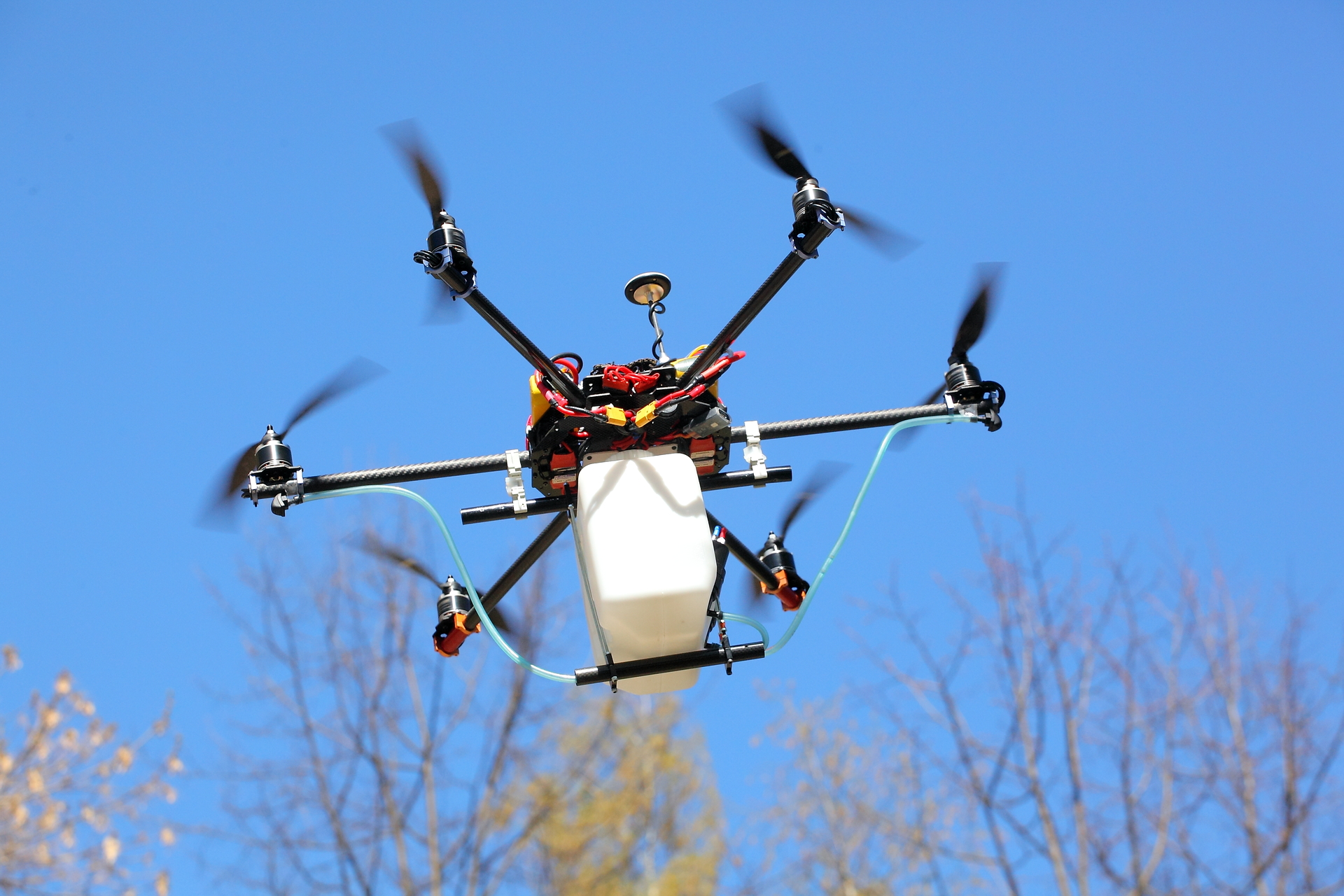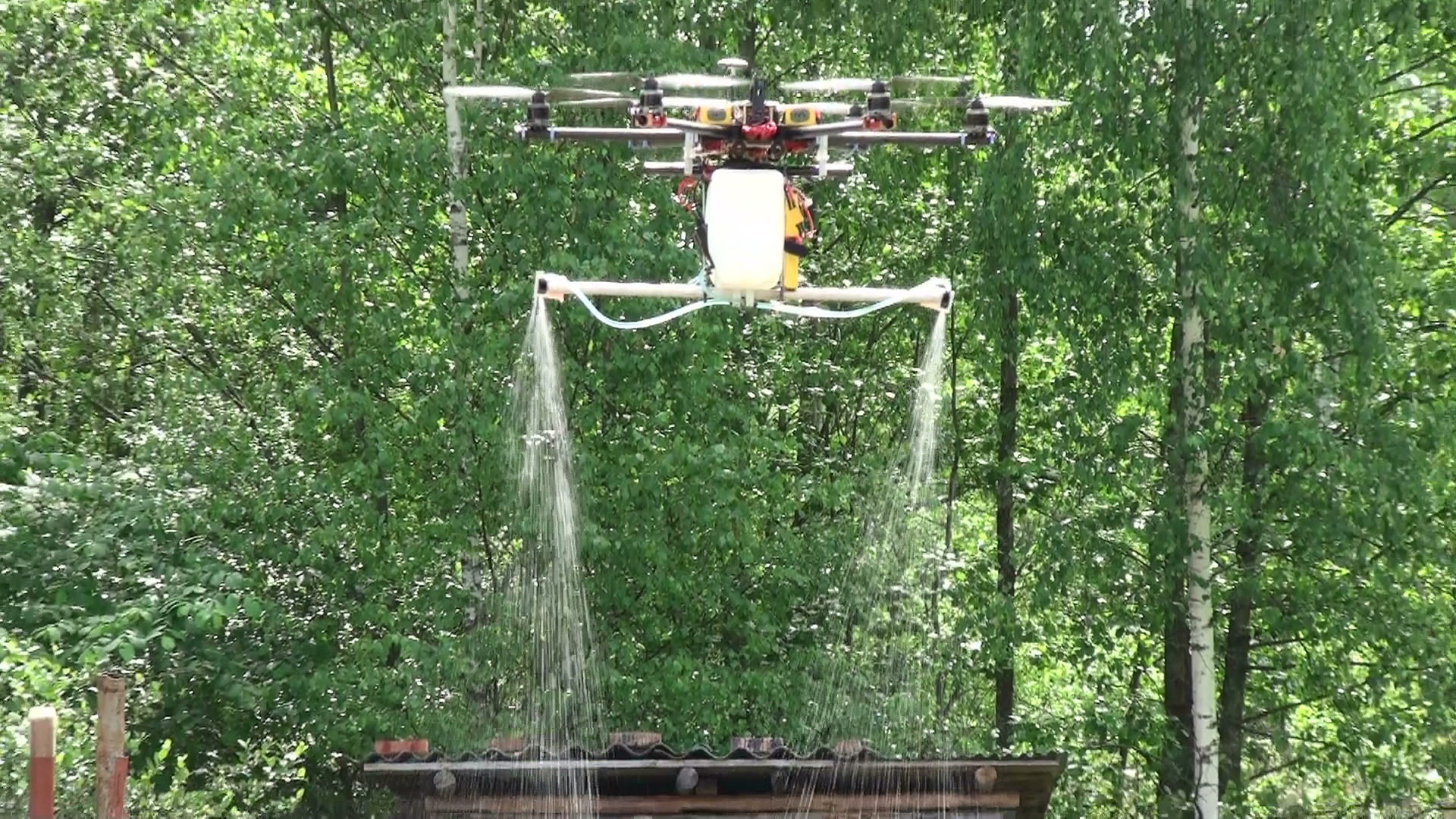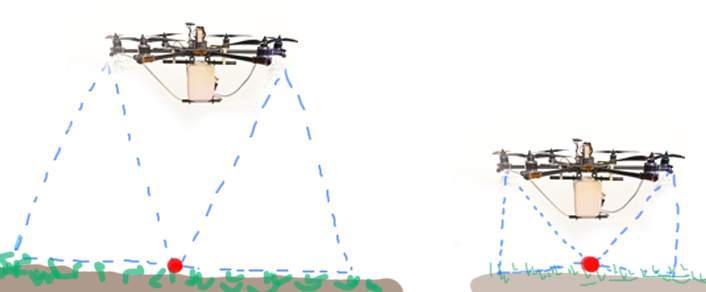"Drone for agriculture" or how to protect plants without much effort
Good day to all. Of course, this article is not very useful for people living in megacities, however, I think it will be useful for people living "close to agriculture". Just recently, the well-known DJI company launched a new product on the market - “ Agras MG-1"- a copter, which is a" spray ". Simply put, this is an octocopter carrying a tank of liquid and a sprayer on board. "ABOUT! They finally thought of it, I thought. This idea was the topic of my dissertation at the institute, however, the "professors" sitting there said: - "And what's new? They’ve already sprayed planes, and there’s essentially no scientific novelty here. ” Well, after several such phrases, I realized that no one needs this with us except me. And to do something that no one needs, I do not like. Honestly, it was unpleasant that such an innovation was essentially “kicked”. On this my "scientific" activity and has subsided.
And I decided to write this article after I saw the price tag for the new DJI Argas, and this price tag was $ 15,000. Are you kidding me?! $ 15,000 for a copter, the red price of which is 4 thousand, well, a maximum of 5 with all its super electronics.

In order not to be unsubstantiated, I will give the design of my “copter-sprayer”. Initially, my copter, like many, was assembled for aerial photography. But at a wonderful moment, I realized that this is not the end of the matter.
Now this setup has already been disassembled and assembled on "more high-torque" engines, but at that time it looked like this:

Copter:
I must say right away that these are not the best components (batteries and regulators), so you should not rely on them.

As for the sprayer, there were several modifications. The first step was to find the nozzles. I tried a lot of car nozzles (by the way, just the BMW nozzles in the photo above), but as you can see in the photo, they sprayed the liquid poorly, because to spray a drop of liquid should have been almost in the form of “fog”. This is necessary so that the plants are not fired by pesticides and evenly covered. In short, after a long search, I found them: nozzles with cylindrical spray * and a variable spray angle. These nozzles are serviced, which is important enough.
The pipeline itself is an ordinary car windshield washer hose, which is sold in any car shop (100-200 rubles).
What is the capacity of the sprayer? Nothing special. :)
An ordinary washer reservoir from the VAZ 2109 with two native pumps (you can put one, it’s enough). In my opinion, it costs about 200-300 rubles together with pumps.
A piece of tubing (or any hard stick) is also needed for the nozzles to be spaced apart.
By the way, it is best to position the nozzles strictly under the copter blades. The fact is that in addition to a vertical drop, the water then swirls due to the rotation of the blades. As a result, our finely divided mixture becomes even finer.
Now I’ll tell you about the “most complicated system” of turning pumps on and off.
Turnigy switch is an ordinary switch connected to an RC receiver. That is, due to it, we remotely turn pumps on and off. Well, the 12V battery is mounted directly on the tank to power these pumps.
Now a little more theory. Spraying from the nozzle takes place in the form of a cone. And if we have 2 nozzles, then we get 2 cones. And at a certain altitude of the copter, these cones begin to intersect.

And the point at which the liquids intersect is called the “overlap point”.
In other words, there will be 1 layer of liquid along the edges, and 2 layers in the center. To avoid this, I put a servo on each nozzle. As a result, I could control the angle of the nozzles, creating a minimum overlap point.

As for the processing speed, then I think everything is clear:
After experimenting on a rye field of 60x20 meters with a plant height of 2 meters, the copter coped in 7 minutes (including refueling), and a person with a manual sprayer got lost there.
And at the expense of safety, here we are next to pesticides only at the time of refueling (but the liquid is not finely dispersed, therefore less dangerous for the body). At the time of spraying, the copter is located at a distance from the pilot. But when spraying with manual sprayers, a person is in close proximity. Here is the conclusion of this whole undertaking!
Oh yes, there is one more conclusion:
First, I want to ask a question. Is the goal we pursued by creating such an aggregate achieved? Experiments have shown that yes. The costs for this device together with the copter, with the control panel, with the sprayer, and even with a bag of pesticides turned out no more than 1-1.5 thousand dollars. And if you take into account my current setup (an updated copter, which can carry 8–9 liters on 35 engines) no more than 2 thousand dollars.
And now the second question. DJI company? Are you crazy there? What are 15 thousand dollars? A?

Spraying video:
ps Thanks to Victor for this material and experience.
That's all, with you there was a simple service for choosing complex Dronk.Ru equipment .
Do not forget to subscribe to our blog , there will be many more interesting things.
pps * - links marked with a referral asterisk, so you can save extra by returning a cashback of up to 4%. More details at Dronk.ru/cashback/ or you can get 6.5% by purchasing them through the LetyShops cashback service .
Our other publications:

And I decided to write this article after I saw the price tag for the new DJI Argas, and this price tag was $ 15,000. Are you kidding me?! $ 15,000 for a copter, the red price of which is 4 thousand, well, a maximum of 5 with all its super electronics.
In order not to be unsubstantiated, I will give the design of my “copter-sprayer”. Initially, my copter, like many, was assembled for aerial photography. But at a wonderful moment, I realized that this is not the end of the matter.
Now this setup has already been disassembled and assembled on "more high-torque" engines, but at that time it looked like this:

Copter:
- Frame tarot FY680 *
- Engines t-motor 2814-10 *
- Turnigy plush 30a regulators
- Naza V1 + gps * controller (link to the light version)
- Batteries zippy compact 4s 25c 5000mah
I must say right away that these are not the best components (batteries and regulators), so you should not rely on them.

As for the sprayer, there were several modifications. The first step was to find the nozzles. I tried a lot of car nozzles (by the way, just the BMW nozzles in the photo above), but as you can see in the photo, they sprayed the liquid poorly, because to spray a drop of liquid should have been almost in the form of “fog”. This is necessary so that the plants are not fired by pesticides and evenly covered. In short, after a long search, I found them: nozzles with cylindrical spray * and a variable spray angle. These nozzles are serviced, which is important enough.
The pipeline itself is an ordinary car windshield washer hose, which is sold in any car shop (100-200 rubles).
What is the capacity of the sprayer? Nothing special. :)
An ordinary washer reservoir from the VAZ 2109 with two native pumps (you can put one, it’s enough). In my opinion, it costs about 200-300 rubles together with pumps.
A piece of tubing (or any hard stick) is also needed for the nozzles to be spaced apart.
By the way, it is best to position the nozzles strictly under the copter blades. The fact is that in addition to a vertical drop, the water then swirls due to the rotation of the blades. As a result, our finely divided mixture becomes even finer.
Now I’ll tell you about the “most complicated system” of turning pumps on and off.
Turnigy switch is an ordinary switch connected to an RC receiver. That is, due to it, we remotely turn pumps on and off. Well, the 12V battery is mounted directly on the tank to power these pumps.
Now a little more theory. Spraying from the nozzle takes place in the form of a cone. And if we have 2 nozzles, then we get 2 cones. And at a certain altitude of the copter, these cones begin to intersect.

And the point at which the liquids intersect is called the “overlap point”.
In other words, there will be 1 layer of liquid along the edges, and 2 layers in the center. To avoid this, I put a servo on each nozzle. As a result, I could control the angle of the nozzles, creating a minimum overlap point.

As for the processing speed, then I think everything is clear:
After experimenting on a rye field of 60x20 meters with a plant height of 2 meters, the copter coped in 7 minutes (including refueling), and a person with a manual sprayer got lost there.
And at the expense of safety, here we are next to pesticides only at the time of refueling (but the liquid is not finely dispersed, therefore less dangerous for the body). At the time of spraying, the copter is located at a distance from the pilot. But when spraying with manual sprayers, a person is in close proximity. Here is the conclusion of this whole undertaking!
Oh yes, there is one more conclusion:
First, I want to ask a question. Is the goal we pursued by creating such an aggregate achieved? Experiments have shown that yes. The costs for this device together with the copter, with the control panel, with the sprayer, and even with a bag of pesticides turned out no more than 1-1.5 thousand dollars. And if you take into account my current setup (an updated copter, which can carry 8–9 liters on 35 engines) no more than 2 thousand dollars.
And now the second question. DJI company? Are you crazy there? What are 15 thousand dollars? A?

Spraying video:
ps Thanks to Victor for this material and experience.
That's all, with you there was a simple service for choosing complex Dronk.Ru equipment .
Do not forget to subscribe to our blog , there will be many more interesting things.
pps * - links marked with a referral asterisk, so you can save extra by returning a cashback of up to 4%. More details at Dronk.ru/cashback/ or you can get 6.5% by purchasing them through the LetyShops cashback service .
Our other publications:
- What to give a boom for the New Year in the range of 10-20 $? Part 2
- Our small joys or how to please a geek for the new year within $ 10-20?
- The world's first pocket hexacopter for $ 18 - MJX X901
- Are there real discounts on gadgets or what does AliExpress bring to us?
- Black Friday from China - instructions for use or how to buy a tablet for 1 cent?

